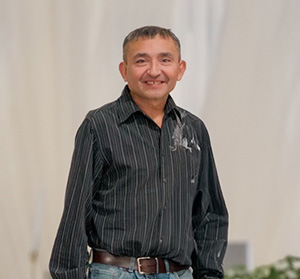 Gabriel Gonzalez, 52, of Arden is one of countless people still unaccounted for after Helene. He stands with childhood friend Ulices Garcia, both of El Salvador. (Photos provided) SWANNANOA — Asheville-area parishioner Gabriel Gonzalez disappeared the day Helene hit.
Gabriel Gonzalez, 52, of Arden is one of countless people still unaccounted for after Helene. He stands with childhood friend Ulices Garcia, both of El Salvador. (Photos provided) SWANNANOA — Asheville-area parishioner Gabriel Gonzalez disappeared the day Helene hit.
He’d gone to work in driving rain at Ingles Markets’ distribution center on the banks of the Swannanoa River – where co-workers called him “the happy one” because he was always singing as he loaded tractor-trailers for the regional grocery store chain.
Now, his friends and fellow parishioners fear the worst: They found Gabriel’s red jeep four days after the storm, buried in mud along the river, which rose 19 feet during the storm to a level not seen since 1791 and roughly 10 feet higher than the National Weather Service’s major flood stage.
Witnesses who live along the river told Gabriel’s friends they saw a red jeep floating down the river and that someone had tried to get the driver to jump. “But the current took him,” said Antonio Garcia, the Asheville-area Hispanic ministry coordinator for the Diocese of Charlotte.
Witnesses also told Garcia they saw rescuers pull a lifeless man from the jeep the next day, he said.
“We are heartbroken,” Garcia said. “We are waiting official word from the county, but they are struggling to identify everybody they have found.”
Indeed, Gabriel Gonzalez, 52, of Arden is one of countless people still unaccounted for after Helene swept through on Sept. 27. But friends have posted a GoFundMe page to raise money to transport Gabriel’s body back to his native El Salvador once identification is made.
Garcia and his brother Ulices grew up with Gabriel in El Salvador, in a Franciscan parish where they attended Catholic youth camps, sang Franciscan songs, and where Gabriel served as a catechist teaching the faith to children. He left school at a young age to work in the fields to help support his family.
Gabriel moved to the U.S. in 1998, where the Garcias say he lived simply, in an apartment, “without presumption” – working, growing vegetables and sending money home to support his mother, two sisters and three nieces.
“He was very responsible. He worked hard, and he especially loved to work the land because he felt the connection with his roots,” Antonio Garcia said. “Every summer he would plant corn and beans and tomatoes, and he would share them with everybody.”
 GonzalezGabriel also embraced St. Francis’ model of living “humbly and charitably,” Ulices Garcia said. He consistently attended Spanish Masses in the Asheville area, at St. Eugene or St. Barnabas and sometimes at St. Lawrence Basilica.
GonzalezGabriel also embraced St. Francis’ model of living “humbly and charitably,” Ulices Garcia said. He consistently attended Spanish Masses in the Asheville area, at St. Eugene or St. Barnabas and sometimes at St. Lawrence Basilica.
“I have a deep void in my heart,” Ulices Garcia said. “He was always there for me, always reaching out…I thought of him as a brother.”
Gabriel loved the U.S. but was also proud of where he came from. He often wore a blue-and-white striped shirt resembling the Salvadorian flag or one emblazoned with “la flor de izote,” his country’s national flower.
“He was very joyful, always smiling. And he loved soccer,” Ulices Garcia said. “Even though he didn’t have children, he supported his nieces in El Salvador, helped them go to college.
“He was very responsible. Like even in bad weather, he went to work that day.”
Nohemi Luna was sad to hear about Gabriel. A parishioner at St. Margaret Mary Church in Swannanoa, she worked with Gabriel at Ingles – and she too got swept up by water on her way to work.
“The big wave took me with my car,” Luna said tearfully. “I thought it was the end. But the water just picked me up and flipped me around and pushed me back out.”
The Garcias are working with the Salvadorian Consulate to find their friend – and send him home.
— Liz Chandler
Related news:
-
Bishop Michael Martin, OFM Conv.: Are we ready to walk with those in need?
- How you can help
-
Friends search for Arden parishioner who lived ‘humbly and charitably’
-
National Catholic Charities grant boosts diocese’s Helene relief efforts
- Charlotte Catholic students help Immaculata School prepare for reopening
- Grieving Swannanoa residents greet bishop
- Helene relief flows in


